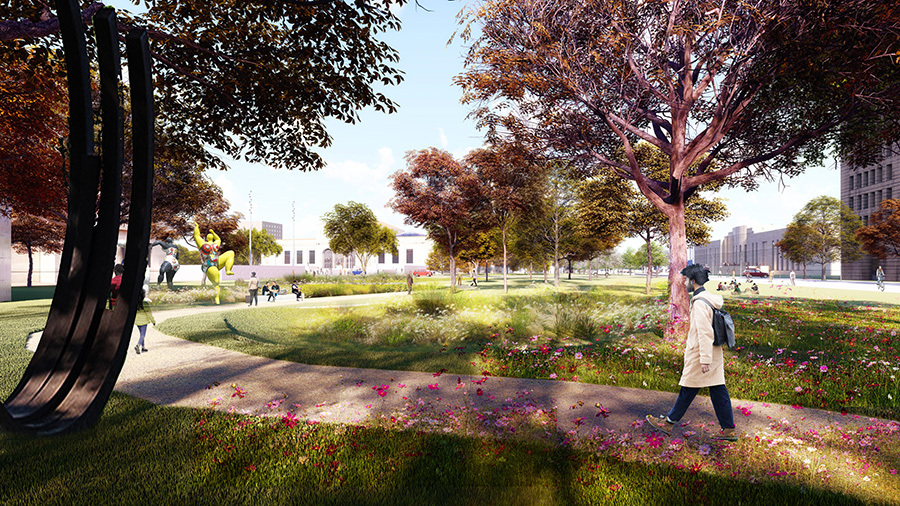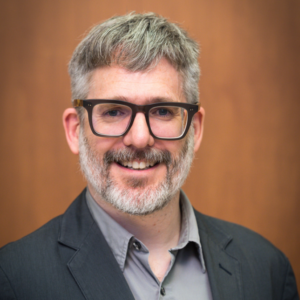Three University of Michigan faculty members are part of a team that won an international design competition that will help revitalize Midtown Detroit, Michigan by uniting 12 cultural and educational institutions located in Detroit’s Midtown and change the way visitors and Detroiters experience the area.
 The winning project, titled “Detroit Square,” offers a “locally rooted, contextually, and environmentally responsive framework” to unify 12 public institutions and to create an inclusive cultural district spanning 83 acres in Detroit. It includes tweaks to the orientation of specific services and spaces within many of the buildings, a reimagining of various underutilized spaces, and a complete overhaul of the grounds surrounding each institution.
The winning project, titled “Detroit Square,” offers a “locally rooted, contextually, and environmentally responsive framework” to unify 12 public institutions and to create an inclusive cultural district spanning 83 acres in Detroit. It includes tweaks to the orientation of specific services and spaces within many of the buildings, a reimagining of various underutilized spaces, and a complete overhaul of the grounds surrounding each institution.
Some ideas from the team’s radical proposal include plans for a “data jockey booth” to serve as a hub for both performance and technology infrastructure; a “canopy”—or series of domes enclosed in glass—that would serve as additional exhibition and event space outside of the DIA, a “Respect Cafe” outside of the Charles Wright Museum of African American History that pays homage to the late Aretha Franklin; and a “public living room” at the Detroit Library.
“Our proposal is not calcified or absolute; it is designed to evolve,” said Anya Sirota, an associate professor of architecture at the U-M Taubman College of Architecture and Urban Planning, and principal of Detroit-based studio Akoaki. “We’ve provided an operational diagram rather than a finished proposal, and now it needs to be adjusted with real input from all of the stakeholders and community.”
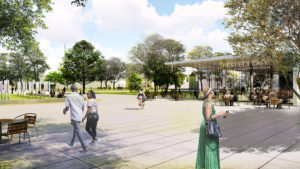 The winning team includes Sirota, Harley Etienne, an urban planner and assistant professor of urban and regional planning at the U-M Taubman College; and John Marshall, an associate professor at the U-M Penny W. Stamps School of Art & Design and Taubman College, and co-director of the Detroit-based hybrid design studio rootoftwo.
The winning team includes Sirota, Harley Etienne, an urban planner and assistant professor of urban and regional planning at the U-M Taubman College; and John Marshall, an associate professor at the U-M Penny W. Stamps School of Art & Design and Taubman College, and co-director of the Detroit-based hybrid design studio rootoftwo.
“We are so grateful to have won this,” Etienne said. “We’re excited to start this process. We feel a deep sense of responsibility for this project.”
Other team members include Jean Louis Farges of Akoaki; Cézanne Charles, co-director of rootoftwo and alumna of the U-M Ford School of Public Policy; and Agence Ter, an internationally renowned landscape and urban design studio based in France.
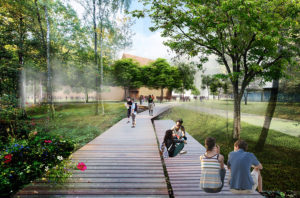 “Having been selected, it feels very good to have the confidence of the participating institutions and the city—each willing to work with us on a process that will hopefully culminate in a response calibrated to many parallel and individual needs, while still retaining a sense of unity and place,” Sirota said. “The competition organizers are taking a chance on a project dedicated to creating inclusive social environments through process driven work.”
“Having been selected, it feels very good to have the confidence of the participating institutions and the city—each willing to work with us on a process that will hopefully culminate in a response calibrated to many parallel and individual needs, while still retaining a sense of unity and place,” Sirota said. “The competition organizers are taking a chance on a project dedicated to creating inclusive social environments through process driven work.”
The DIA Plaza/Midtown Cultural Connections competition was launched in 2017 by Midtown Detroit Inc. and the Detroit Institute of Arts. All told, 44 submissions from at least 10 countries and 22 cities were narrowed down to three finalist teams, who presented their ideas to a panel of judges in January.
One judge, Detroit city planner Maurice Cox, said he felt privileged to be the planning director at a time when “Detroit is daring to dream big” again. “The team brought together something that I would say is a world-class sensibility, an international sensibility that is steeped in local knowledge. And that local knowledge, I would contend, is what distinguished them from all others,” Cox said. “So this perfect mixture of international reach and local knowledge produced the winners that you see today.”
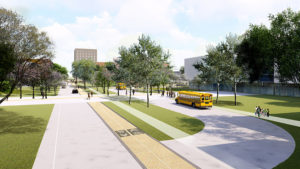 Another idea that made the Detroit Square idea take off includes the opportunity “to leapfrog the current generation of technology and do something that is very progressive and future proof,” Marshall said. Public wifi, 5G connection, LED controllable lighting, sound projection mapping and outdoor urban screens that utilize sensors throughout the square are also part of the master plan.
Another idea that made the Detroit Square idea take off includes the opportunity “to leapfrog the current generation of technology and do something that is very progressive and future proof,” Marshall said. Public wifi, 5G connection, LED controllable lighting, sound projection mapping and outdoor urban screens that utilize sensors throughout the square are also part of the master plan.
“We’re obviously viewing this through a technology lens, but we’re also looking at it through a social justice lens,” Marshall said. “We’re going to design for 5G in a way that big tech companies won’t—we’re interested in protecting the privacy of the citizens that interact with the space.”
The team also looked at ways to create more parking, reroute traffic and adjust speeds of cars moving through the district to promote a more pedestrian-friendly experience.
“I think it’s very exciting for U-M faculty stepping up to play, hopefully, a very big role in setting the shape of this neighborhood, this crown jewel of the city for decades to come,” said Taubman College dean Jonathan Massey, who served as one of the 11 competition jurors. “I hope it has the impact we are imagining.”
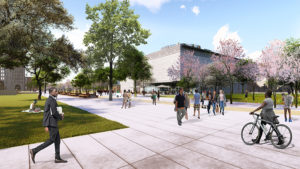 “I also think it will be good for the university that the Rackham building is going to pull us into this neighborhood more fully than we have been in the past. And I’m hoping that that double connection, the real estate of the Rackham building and the faculty role in the design, will help us in Ann Arbor, Flint and Dearborn to have a stronger presence and connection and engagement with this amazing city,” Massey continued.
“I also think it will be good for the university that the Rackham building is going to pull us into this neighborhood more fully than we have been in the past. And I’m hoping that that double connection, the real estate of the Rackham building and the faculty role in the design, will help us in Ann Arbor, Flint and Dearborn to have a stronger presence and connection and engagement with this amazing city,” Massey continued.
Beginning in July, the team will start the first in a three-phased conceptual planning process. Over the next 18 months, the team will conduct a topographic survey, tree survey, mobility study, parking study, stormwater management survey, lighting survey and more.
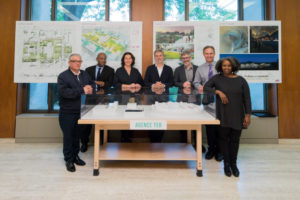
Left to right: Jean Louis Farges, Harley Etienne, Anya Sirota, Olivier Phillipe, John Marshall, Donald Carpenter andCezanne Charles. Photo courtesy of UM.
They’ll also meet with each of the stakeholders, and are planning to open a storefront in downtown Detroit in order to be available to the community as the project progresses. It is estimated to take seven to 10 years to complete.
The design plan for Detroit Square takes Detroit to another level, Cox said. “It allows each institution to not only reinforce its identity, but to grow in magnitude as a result of being finally, intentionally brought together by a public realm strategy.”
John Marshall co-directs Detroit-based studio rootoftwo with his partner Cézanne Charles, an alumna of the U-M Ford School of Public Policy. Rootoftwo makes hybrid design projects that test the materiality and consequences of technology at the city-scale.
Below, Marshall talks about working his Detroit Square work in a Q&A format:
What made you decide to join a team to “reimagine Detroit’s arts and cultural district?
Marshall: I think that for all of us, it was hard to pass up the opportunity. When we began this a little more than a year ago, we knew that there was a perspective and a point of view that we wanted to put on the table, and that it might otherwise not necessarily be there due to the fact that this was an international competition. Because we have all been working in the region for over a decade, I think we had a unique sensibility and sensitivity to the local context. We thought we could change the nature of the competition by being explicit about some of the things that really matter to us.
What was was your contribution to the project on behalf of the work that rootoftwo does?
Marshall: It’s a little harder for us to show what we do because it is not necessarily visible in a rendering. We’ve been building technology-based public art projects for nearly 10 years, so we bring knowledge of the kind of infrastructure that it requires to deploy these projects. We’re on the cusp of a massive change—the way that technology works. Everyone’s heard about 5G, the fifth generation of mobile technology, but I don’t know if everyone understands what that means, yet. This technology is going to change everything once again, and we’re designing to incorporate and anticipate those imminent changes.
How are you designing for a future that will involve 5G? How might that technology change our public spaces?
Marshall: In other countries at the moment there’s a huge real estate grab for street lights because for 5G connectivity you need an array of connection points at consistent distances, so as you drive past in your car at speed you can still connect with the right cadence without dropping the signal. So being able to redesign the wayfinding and the street lighting for the site, which needs to be done as part of the project, is a massive opportunity to put in place all of the technologies that are going to come into fruition over the next decade. We want to take advantage of the massive investment that’s going to be made, and in the end, not only get fancy RGB lighting but also have the capacity for different kinds of onsite engagement. We understood this is an opportunity for a new type of cultural platform on a scale that has never been possible before.
In your presentation, you talked about creating an “equitable smart city.” What does that mean in terms of the city of Detroit?
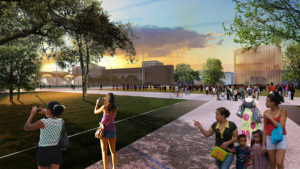 Marshall: We’re obviously viewing this through a technology lens, but we’re also looking at it through a social justice lens—and that’s something that big tech companies are not necessarily going to do. So we have an opportunity through culture, to engage with those systems and to engage with those technologies in a very different way. You can put sensors and cameras everywhere, and that’s definitely coming—there’s the whole facial recognition thing, too. However, you can sense the presence of a human being without needing to know the identity and commercial potential of that person. So while we might track use and engagement of the site, we envision more equitable systems that will be set up to protect privacy. We have an opportunity to do something that is first of its kind, deploying that technology through an ethical lens.
Marshall: We’re obviously viewing this through a technology lens, but we’re also looking at it through a social justice lens—and that’s something that big tech companies are not necessarily going to do. So we have an opportunity through culture, to engage with those systems and to engage with those technologies in a very different way. You can put sensors and cameras everywhere, and that’s definitely coming—there’s the whole facial recognition thing, too. However, you can sense the presence of a human being without needing to know the identity and commercial potential of that person. So while we might track use and engagement of the site, we envision more equitable systems that will be set up to protect privacy. We have an opportunity to do something that is first of its kind, deploying that technology through an ethical lens.
How does it feel to get to move forward with your proposal?
Marshall: This really goes back to the reason that we had to apply. We’ve all been working with these communities for so long and we feel the perspectives of all the people that we’ve worked with need to be represented. This is a once-in-a-generation opportunity and we feel the weight of this responsibility. I mean, I think if we’re honest, we originally thought we could, at the least, change the nature of the conversation by putting our ideas on the table. And then we got through to the final three, and then we were selected as winners—and I’m just really proud that all the stakeholders appreciated our knowledge and perspective and trust us to carry it through.
All renderings are copyright © Agence Ter, Akoaki, rootoftwo, and Harley Etienne.
The interview with John Marshall was conducted by Sydney Hawkins, and originally appeared on the University of Michigan website. Reprinted here with permission.

